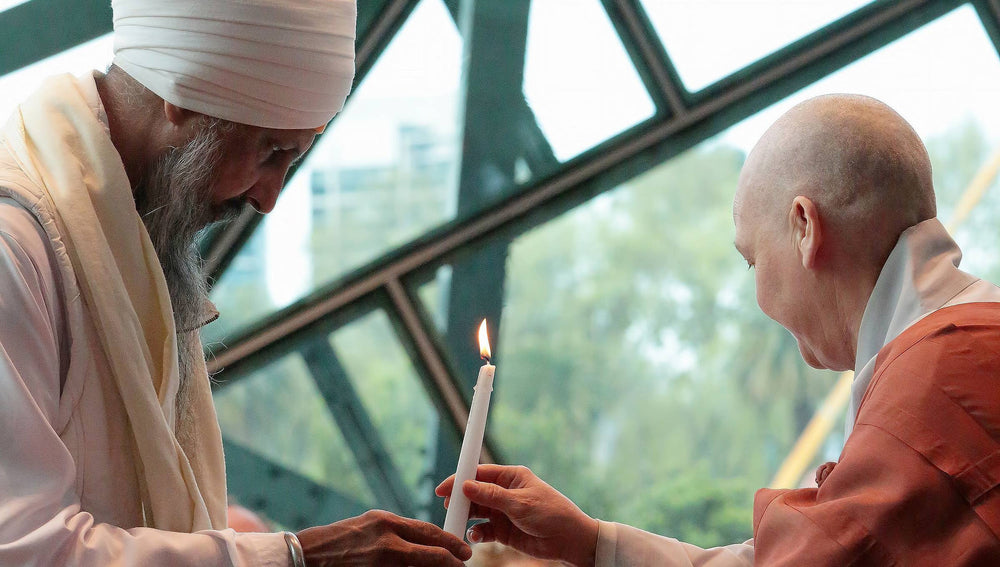
I recently received an email from the organiser of an initiative called Wake Up for Peace asking me if I'd like to participate in a meditation event for the UN's International Day of Peace. The idea was to invite Rabbis, Bishops and spiritual luminaries from all faiths, as well as leaders from politics, business, academia and healthcare to come together and meditate on peace for half an hour. She wanted to know if I'd join them.
I agreed, thinking what a wonderful idea it was. But part of me was also super skeptical. I couldn’t imagine all those influential people coming together in one place with no purpose other than to meditate. There would be no public speaking, no conferencing and no discussion papers. Just meditation.
But on Monday morning that is exactly what happened. 300 people who had heard about the event joined us at Federation Square in the heart of Melbourne and together we sat and meditated on the idea of peace for 30 minutes. The atmosphere was charged with a deep sense of togetherness despite our different backgrounds, cultures and beliefs. It was spectacular.
The experience was special but as a journalist I must confess the whole thing sounded a little idealistic to me at first. When the world is so full of conflict, pain and suffering, what good could a group of people meditating for half an hour really do?
Nevertheless, energised by the positive mood that I took away with me, I was inspired to do a little research. It turns out, a phenomenon scientists call emotional contagion shows that moods like the one we created during our peaceful meditation can make a difference by spreading just like the common cold.
For instance, research shows that we can ‘catch’ positive emotions expressed by our leaders. We also become more collaborative and efficient under positive leadership. We see these positive leaders as more charismatic than their negative peers and their positive mood has a direct impact on ours.
But it’s not just our leaders that have the potential to spread their mood around. New research published just last month found that being surrounded by friends with a healthy mood could halve the probability of developing depression and double the probability of recovering from depression.
One scientist at the forefront of emotional contagion is Nicholas Christakis from Yale University. In a 2008 study he showed if you have happy friends, the probability that you will be happier goes up by 25 per cent. Christakis also demonstrated that emotional contagion is possible via social media. In a study of millions of Facebook users, he found that on rainy days, people were more likely to post negative status updates and their negativity could influence their friends in sunny cities to also post negative updates. No wonder Christakis was recently nominated by Time magazine as being one of the top 100 most influential people in the world.
Another controversial study of 689,000 users of Facebook found that people’s moods could be deliberately manipulated by filtering positive or negative emotional content from their news feeds. Needless to say, the study sparked uproar from those already concerned about the social media network’s influence on our lives. Yikes. The more I discover about emotional contagion, the more I feel my skepticism about our Wake Up for Peace meditation experiment melt away. The implication of research like this is significant. It shows that the emotions we express, both in person and online can ripple through communities to generate a large-scale synchrony.
After the event, we were invited to reflect on ways we could take this simple concept to a new level and I’m happy to say we’ll be doing it all over again next year. But it also got me thinking about my own role as a journalist and the responsibility that comes with that role. From the very first lecture I attended at university the mantra ‘if it bleeds, it leads’ was drilled into me. I have been primed to always look for the negative angle on a story.
A few years ago I made the decision to leap out of the mainstream and instead dedicate my energies to The Connection, a film and website to explore and explain science based solutions for people with chronic illness. The intention of this project is to provide hope to people who feel they have run out of options. Although it’s been a hard road to travel, I’m happy to say that the Wake Up for Peace event has reinvigorated my dedication to the project. Perhaps, if I keep at it, some of my positivity will catch on.





 The Connection (DOWNLOAD-TO-OWN)
The Connection (DOWNLOAD-TO-OWN) My Year Of Living Mindfully - Book
My Year Of Living Mindfully - Book




